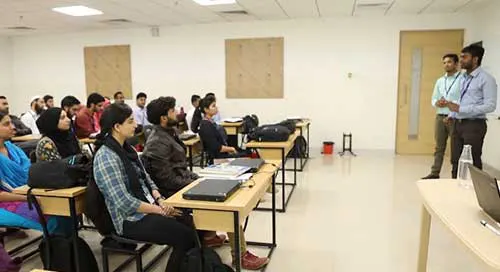Internal Mobility in Recruiting
 Blog by Pallav Saxena
Internal mobility is an essential part of a comprehensive talent acquisition strategy. These resources promotes greater engagement in the workplace and makes your organization more resilient during downturns.
Internal mobility, similar to job rotation, is when an organisation moves their employees across different roles within an organization.
While recruiting outside your organization is important when it comes to fresh ideas, many companies overlook the most promising talent within their company. Failure to optimize the potential of your existing employees could discourage them from staying in your firm and push them towards seeking employment elsewhere.
The recent pandemic created unforeseen obstacles for external recruiting. It has never been more important than now to optimize your internal mobility strategy.
Here are the most important elements of creating an effective strategy:
Effective Management
Effective management is a foundation to internal mobility. Great managers must do the following:
1. Identify their top talent and potential
2. Build trust with the team
3. Consistently discuss their team’s career goals and map ways to meet those goals within the organization itself.
4. Mentor employees to reach their goals, even if that requires leaving the company.
Make internal mobility the foundation of your culture
Why would organisations want to help employees, especially the most talented ones, leave their organization? The answer lies in building a corporate culture that employees don’t want to leave.
Effective management helps build a work positive environment that signals to employees and external candidates that their company is invested in their personal growth and success.
Showing that you care about their career goals is one of the best ways to show that remaining with your firm might actually be the best place to pursue their goals. It also distinguishes your company’s policies from your competitors’, which can prove to be a highly effective recruiting strategy. It helps align your firm’s goals with those of your employees, boost morale, enhances engagement throughout your organization, and helps your workers feel like they are an essential part of the company, rather than a bolt in its machine.
While “climbing the corporate ladder” was once considered the best and only method of advancing career, flatter organizations benefit from programs that allow employees to move within different teams. This lateral movement enhances collaboration overall and eases disruption when new roles are filled by those who already know your company and culture.
Ultimately, an effective talent pipeline boils down to how you plan, strategize, and leverage technology to sustain long-term business needs. The demand for the most competent candidates is only set to increase, getting ahead of the curve will allow you to hire better talent.
This is a very important time for recruiters. The landscape for candidates is now drastically different from the past years. Compassion, flexibility, and understanding will go a long way in building lasting relationships and adapting to the realities of a post-COVID world.
Business continuity is of course still a top priority for organizations at the moment. Yet, the relationships and the talent that recruiters retain now will reward with loyalty down the road.
Blog by Pallav Saxena
Internal mobility is an essential part of a comprehensive talent acquisition strategy. These resources promotes greater engagement in the workplace and makes your organization more resilient during downturns.
Internal mobility, similar to job rotation, is when an organisation moves their employees across different roles within an organization.
While recruiting outside your organization is important when it comes to fresh ideas, many companies overlook the most promising talent within their company. Failure to optimize the potential of your existing employees could discourage them from staying in your firm and push them towards seeking employment elsewhere.
The recent pandemic created unforeseen obstacles for external recruiting. It has never been more important than now to optimize your internal mobility strategy.
Here are the most important elements of creating an effective strategy:
Effective Management
Effective management is a foundation to internal mobility. Great managers must do the following:
1. Identify their top talent and potential
2. Build trust with the team
3. Consistently discuss their team’s career goals and map ways to meet those goals within the organization itself.
4. Mentor employees to reach their goals, even if that requires leaving the company.
Make internal mobility the foundation of your culture
Why would organisations want to help employees, especially the most talented ones, leave their organization? The answer lies in building a corporate culture that employees don’t want to leave.
Effective management helps build a work positive environment that signals to employees and external candidates that their company is invested in their personal growth and success.
Showing that you care about their career goals is one of the best ways to show that remaining with your firm might actually be the best place to pursue their goals. It also distinguishes your company’s policies from your competitors’, which can prove to be a highly effective recruiting strategy. It helps align your firm’s goals with those of your employees, boost morale, enhances engagement throughout your organization, and helps your workers feel like they are an essential part of the company, rather than a bolt in its machine.
While “climbing the corporate ladder” was once considered the best and only method of advancing career, flatter organizations benefit from programs that allow employees to move within different teams. This lateral movement enhances collaboration overall and eases disruption when new roles are filled by those who already know your company and culture.
Ultimately, an effective talent pipeline boils down to how you plan, strategize, and leverage technology to sustain long-term business needs. The demand for the most competent candidates is only set to increase, getting ahead of the curve will allow you to hire better talent.
This is a very important time for recruiters. The landscape for candidates is now drastically different from the past years. Compassion, flexibility, and understanding will go a long way in building lasting relationships and adapting to the realities of a post-COVID world.
Business continuity is of course still a top priority for organizations at the moment. Yet, the relationships and the talent that recruiters retain now will reward with loyalty down the road.













